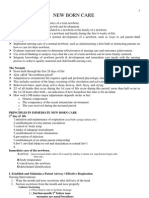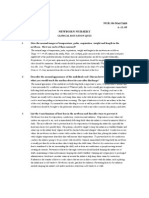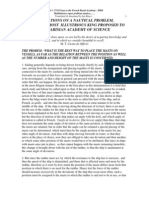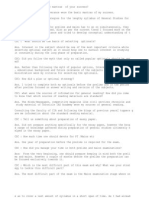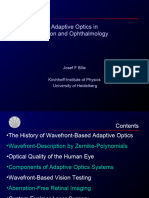0 ratings0% found this document useful (0 votes)
12 viewsThe APGAR Scoring System: Score of 0 Score of 1 Score of 2 Component of Acronym
The APGAR Scoring System: Score of 0 Score of 1 Score of 2 Component of Acronym
Uploaded by
Anonymous hMjlyjPgZThe document describes the APGAR scoring system used to evaluate newborns. It assigns scores of 0, 1, or 2 for five criteria: appearance, pulse, grimace, activity, and respiration. A total score of 0-3 indicates severe depression, 4-6 moderate depression requiring airway clearance, and 7-10 excellent condition.
It then lists goals and steps for immediate newborn care, including establishing respiration by suctioning the mouth/nose, stimulating crying, and positioning to drain secretions. Maintaining warmth to prevent hypothermia is also a goal. Safety and identifying problems requiring attention are the final goals outlined.
Copyright:
© All Rights Reserved
Available Formats
Download as DOCX, PDF, TXT or read online from Scribd
The APGAR Scoring System: Score of 0 Score of 1 Score of 2 Component of Acronym
The APGAR Scoring System: Score of 0 Score of 1 Score of 2 Component of Acronym
Uploaded by
Anonymous hMjlyjPgZ0 ratings0% found this document useful (0 votes)
12 views3 pagesThe document describes the APGAR scoring system used to evaluate newborns. It assigns scores of 0, 1, or 2 for five criteria: appearance, pulse, grimace, activity, and respiration. A total score of 0-3 indicates severe depression, 4-6 moderate depression requiring airway clearance, and 7-10 excellent condition.
It then lists goals and steps for immediate newborn care, including establishing respiration by suctioning the mouth/nose, stimulating crying, and positioning to drain secretions. Maintaining warmth to prevent hypothermia is also a goal. Safety and identifying problems requiring attention are the final goals outlined.
Original Title
module perp.docx
Copyright
© © All Rights Reserved
Available Formats
DOCX, PDF, TXT or read online from Scribd
Share this document
Did you find this document useful?
Is this content inappropriate?
The document describes the APGAR scoring system used to evaluate newborns. It assigns scores of 0, 1, or 2 for five criteria: appearance, pulse, grimace, activity, and respiration. A total score of 0-3 indicates severe depression, 4-6 moderate depression requiring airway clearance, and 7-10 excellent condition.
It then lists goals and steps for immediate newborn care, including establishing respiration by suctioning the mouth/nose, stimulating crying, and positioning to drain secretions. Maintaining warmth to prevent hypothermia is also a goal. Safety and identifying problems requiring attention are the final goals outlined.
Copyright:
© All Rights Reserved
Available Formats
Download as DOCX, PDF, TXT or read online from Scribd
Download as docx, pdf, or txt
0 ratings0% found this document useful (0 votes)
12 views3 pagesThe APGAR Scoring System: Score of 0 Score of 1 Score of 2 Component of Acronym
The APGAR Scoring System: Score of 0 Score of 1 Score of 2 Component of Acronym
Uploaded by
Anonymous hMjlyjPgZThe document describes the APGAR scoring system used to evaluate newborns. It assigns scores of 0, 1, or 2 for five criteria: appearance, pulse, grimace, activity, and respiration. A total score of 0-3 indicates severe depression, 4-6 moderate depression requiring airway clearance, and 7-10 excellent condition.
It then lists goals and steps for immediate newborn care, including establishing respiration by suctioning the mouth/nose, stimulating crying, and positioning to drain secretions. Maintaining warmth to prevent hypothermia is also a goal. Safety and identifying problems requiring attention are the final goals outlined.
Copyright:
© All Rights Reserved
Available Formats
Download as DOCX, PDF, TXT or read online from Scribd
Download as docx, pdf, or txt
You are on page 1of 3
Score of 0
Complexion
Pulse rate
blue or pale
all over
absent
Reflex irritability
no response
grimace
to stimulation
Score of 1
Score of 2
blue at extremities
no cyanosis
body pink
body and
(acrocyanosis)
extremities pink
< 100 beats per
> 100 beats per
minute
minute
Component of
acronym
Appearance
Pulse
grimace on suction or
aggressive
cry on stimulation
Grimace
stimulation
flexed arms and
Activity
none
some flexion
legs that resist
Activity
extension
Respiratory effort
absent
weak, irregular,
gasping
strong, lusty cry
Respiration
The APGAR Scoring System
(developed by Dr. Virginia Apgar)
*** 0-3 Severely Depressed
4-6 Moderately Depressed, needs airway clearance
7-10 Excellent Condition
Immediate Care of the Newborn
Goals:
1.
2.
3.
4.
To establish, maintain and support respiration.
To provide warmth and prevent hypothermia.
To ensure safety and prevent injury and infection.
To identify actual or potential problems that may require immediate attention.
To establish and maintain respiration
1. Wipe mouth and nose of secretions after delivery of the head.
2. Suction secretion s from mouth and nose;
**Compress bulb syringe before inserting
Suction mouth first, then, the nose
Insert bulb syringe in one side of the mouth
3. A crying infant is a breathing infant. Stimulate baby to cry if baby does not cry
spontaneously or if cry is weak.
**Do not slap the buttocks but rub the soles of the feet.
Stimulate to cry only after secretions are removed
The normal infant cry is loud and lusty. Observe for the following abnormal cry:
High pitched cry indicates hypoglycemia, increased intracranial pressure
Weak cry- prematurity
Hoarse cry laryngeal stridor
4. Oral mucous may cause the newborn, to choke, cough or gag during the first 12
to 18 hours of life. Place infant in a position that would promote drainage of
secretions.
Trendelenburg position head lower than the body.
Side lying position if Trendelenburg positions is contraindicated, place
infant in sidelying position to permit drainage of mucus from the mouth, pale a small
pillow or rolled towel at the back to prevent newborn from rolling back to supine position.
5. keep the nares patent. Remove mucus and other particles that may be cause
obstruction. Newborns are obligatory nose breathers until they are about 3 weeks
old.
Characteristics of Newborn Temperature:
1. newborns loss about 2 to 3 degree centigrade of heat at birth because the
external environment is much cooler than the temperature inside the mothers
womb.
2. Newborns loss heat easily because:
They have immature temperature regulating system
Of very little amount of subcutaneous fat to provide heat in their body
They have a larger body surface
3. They also tend to take on the temperature of their environment.
4. The average newborn temperature at birth is around 37.2 C. It is not unusual
for its temperature to fluctuate during the first few hours after birth but is
should stabilize within 10 hours at a range of 36.5 to 37C.
You might also like
- Seven Japanese Tales by Tanizaki JunichiroDocument93 pagesSeven Japanese Tales by Tanizaki JunichiroMister ConfusiousNo ratings yet
- SCIENCE MONTH PROPOSAL Converted 1 1Document13 pagesSCIENCE MONTH PROPOSAL Converted 1 1Pamela Galve100% (1)
- Einc ReviewerDocument4 pagesEinc ReviewerEricson Candelaria0% (1)
- SUGAR REGULATORY ADMINISTRATION, v. TORMONDocument2 pagesSUGAR REGULATORY ADMINISTRATION, v. TORMONChilzia Rojas100% (3)
- Immediate Care of The NewbornDocument11 pagesImmediate Care of The NewbornHannahKarizaNo ratings yet
- Physiologic Assessment of Newborn, Newborn Adaptation and Normal Growth & DevelopmentDocument4 pagesPhysiologic Assessment of Newborn, Newborn Adaptation and Normal Growth & DevelopmentBernard M. Lapuz FullNo ratings yet
- Immediate Newborn CareDocument4 pagesImmediate Newborn CareDani MichaelaNo ratings yet
- Newborn CareDocument51 pagesNewborn CareHurley ReefNo ratings yet
- PatientDocument6 pagesPatientpasaronjustinNo ratings yet
- Newborn CareDocument120 pagesNewborn Carejuly3ciaNo ratings yet
- Immediate Care of The NewbornDocument99 pagesImmediate Care of The NewbornVializa Abanilla BuladoNo ratings yet
- Newborn CareDocument120 pagesNewborn CareMike CalipayanNo ratings yet
- Establish Respiration and Maintain Clear AirwayDocument4 pagesEstablish Respiration and Maintain Clear AirwaygvespineliNo ratings yet
- Immediate Care of The NewbornDocument4 pagesImmediate Care of The NewbornMichelle GambolNo ratings yet
- Immediate Care of The NewbornDocument4 pagesImmediate Care of The Newbornmelinda100% (1)
- Pregnancy ConfirmationDocument4 pagesPregnancy ConfirmationKath MaulionNo ratings yet
- New Born Care 1Document12 pagesNew Born Care 1gilbertgarciaNo ratings yet
- New Born Care 1Document12 pagesNew Born Care 1Tsuyoshi BangNo ratings yet
- Immediate Care of The Newborn: Establish Respiration and Maintain Clear AirwayDocument9 pagesImmediate Care of The Newborn: Establish Respiration and Maintain Clear AirwayFrancoNo ratings yet
- Newborn CareDocument49 pagesNewborn CareJohn Mark PocsidioNo ratings yet
- Immediate Care of NewbornDocument4 pagesImmediate Care of NewbornjvjohnNo ratings yet
- Immediate NewbornDocument16 pagesImmediate NewbornElizabeth ZamoraNo ratings yet
- Immediate Newborn Care (Autosaved)Document183 pagesImmediate Newborn Care (Autosaved)mftaganas100% (2)
- Immediate Care of The NewbornDocument3 pagesImmediate Care of The NewbornBianca CamilleNo ratings yet
- New Born CareDocument17 pagesNew Born CareHarrison Tallod100% (1)
- Pediatric NeonateDocument13 pagesPediatric Neonatei01eve777No ratings yet
- Apgar Scoring and Vital Signs 1Document16 pagesApgar Scoring and Vital Signs 1Ma. Isabel A. EnriquezNo ratings yet
- Immediate Newborn Care-1Document6 pagesImmediate Newborn Care-1yasserali242424No ratings yet
- Case Scenario 6Document8 pagesCase Scenario 6Micah YapNo ratings yet
- Askep Bayi Baru Lahir BaruDocument22 pagesAskep Bayi Baru Lahir BaruFebian AlfiansyahNo ratings yet
- Immediate Care of NewbornDocument21 pagesImmediate Care of NewbornRaida Marañon Ibrahim100% (2)
- Immediate Care of The New Born: ObjectivesDocument127 pagesImmediate Care of The New Born: ObjectivesSwati SharmaNo ratings yet
- Unit II The NewbornDocument47 pagesUnit II The NewbornmbolleaudreyNo ratings yet
- Newborn (MSC BUK)Document68 pagesNewborn (MSC BUK)Aysha KurfiNo ratings yet
- Newborns Undergo Profound Physiologic Changes at The Moment of BirthDocument8 pagesNewborns Undergo Profound Physiologic Changes at The Moment of BirthUri ELNo ratings yet
- Care of The Newborn PDFDocument5 pagesCare of The Newborn PDFzhai bambalan100% (2)
- Nursing Care of Newborn and FamilyDocument38 pagesNursing Care of Newborn and FamilyLady Jane CaguladaNo ratings yet
- Immediate Nursing Care of The NewbornDocument29 pagesImmediate Nursing Care of The NewbornDrei Lanuzo100% (1)
- Birth AsphyxiaDocument10 pagesBirth Asphyxiasarita Singh MaharjanNo ratings yet
- Nursing Care of The NewbornDocument6 pagesNursing Care of The NewbornJankie Obina Alcaba100% (1)
- Immediate Physical CareDocument73 pagesImmediate Physical CareronelnNo ratings yet
- The Normal NewbornDocument8 pagesThe Normal NewbornCRISPINA LINANGNo ratings yet
- The Newborn Care: Prepared By: 1.moza Sulaiman Al-KhaldiDocument36 pagesThe Newborn Care: Prepared By: 1.moza Sulaiman Al-Khaldimoza92sNo ratings yet
- Baby and Child First Aid 2022Document11 pagesBaby and Child First Aid 2022Nirubhana ArunthavasothyNo ratings yet
- Assessment of The Normal NewbornDocument6 pagesAssessment of The Normal Newborndhalal100% (2)
- 2 NEO Newborn Care 2012Document28 pages2 NEO Newborn Care 2012shambelNo ratings yet
- Incubator CareDocument4 pagesIncubator CareSundaraBharathi100% (1)
- Immediate Care of The NewbornDocument12 pagesImmediate Care of The NewbornLucilyn EbuengaNo ratings yet
- 1 Newborn Care and Physical AssessmentDocument79 pages1 Newborn Care and Physical AssessmentWaleed AhmadNo ratings yet
- New Born ResuscitationDocument49 pagesNew Born ResuscitationdivyamuthyalaNo ratings yet
- Newborn Care 101 2nd SemDocument18 pagesNewborn Care 101 2nd SemFilamae Jayahr CadayNo ratings yet
- Dry The Baby: OK Not OK Not OKDocument9 pagesDry The Baby: OK Not OK Not OKEemyaj JaymeeNo ratings yet
- Newborn Clinical QuizDocument5 pagesNewborn Clinical QuizAmy100% (1)
- NEWBORN ASSESSMENT DajuuuuuuuuuuuuuuuuDocument31 pagesNEWBORN ASSESSMENT Dajuuuuuuuuuuuuuuuuamal abdulrahmanNo ratings yet
- Care of IncubatorDocument3 pagesCare of IncubatorBinal JoshiNo ratings yet
- DR Stuart Crisp DR Per Grinsted: Written byDocument8 pagesDR Stuart Crisp DR Per Grinsted: Written byRizky MarethaNo ratings yet
- Immediate Care of The NewbornDocument4 pagesImmediate Care of The NewbornGrace Ordinario Sabordo100% (2)
- Newborn CareDocument4 pagesNewborn CareJuthika Rani DeyNo ratings yet
- Newborn CareDocument34 pagesNewborn CareThe Blue and Gold RvdNo ratings yet
- Essential Newborn Care (ENC)Document26 pagesEssential Newborn Care (ENC)Yonas TsagayeNo ratings yet
- First Aid & Emergency Companions: First Aid & Emergencies at SeaFrom EverandFirst Aid & Emergency Companions: First Aid & Emergencies at SeaNo ratings yet
- PEDIATRIC FIRST AID: How to respond quickly when your child is in dangerFrom EverandPEDIATRIC FIRST AID: How to respond quickly when your child is in dangerNo ratings yet
- Analysis of Electromagnetic Characteristics of Synchronous Condenser Under Stator Inter-Tum Short Circuit FaultDocument5 pagesAnalysis of Electromagnetic Characteristics of Synchronous Condenser Under Stator Inter-Tum Short Circuit FaultMa QiyanNo ratings yet
- Design and AnalysisDocument5 pagesDesign and AnalysisErolNo ratings yet
- Success Principles - Based On Tantrokta Devisuktam: DevīmāhātmyamDocument7 pagesSuccess Principles - Based On Tantrokta Devisuktam: DevīmāhātmyamSubramaniam PGNo ratings yet
- CFLM2 Final CoverageDocument17 pagesCFLM2 Final CoveragenidsgdgirlNo ratings yet
- Euler-Ship Mast LocationDocument61 pagesEuler-Ship Mast LocationzeldaikNo ratings yet
- PaPIS User Manual - Part I v2.0Document106 pagesPaPIS User Manual - Part I v2.0Rhea BinayaNo ratings yet
- Sales Operation Management of SINGER Bangladesh LTDDocument17 pagesSales Operation Management of SINGER Bangladesh LTDMd.Minhaz AkterNo ratings yet
- Mapeh 8health q3 Summative TestDocument3 pagesMapeh 8health q3 Summative TestJanmae ImperialNo ratings yet
- Thesis Topics in Sociology of EducationDocument8 pagesThesis Topics in Sociology of Educationrachelquintanaalbuquerque100% (2)
- Strategy Presentation - Rocket InternetDocument13 pagesStrategy Presentation - Rocket Internetgovenderdinolan25No ratings yet
- Lab Report - Talayan Q.CDocument10 pagesLab Report - Talayan Q.CDennis SagaoNo ratings yet
- Interview of IAS OfficerDocument3 pagesInterview of IAS OfficerRakesh SableNo ratings yet
- Handbook: Candidate'sDocument68 pagesHandbook: Candidate'sSaheed Olamilekan AdebisiNo ratings yet
- REUTERS-21578: Appendix ADocument26 pagesREUTERS-21578: Appendix AMehdiNo ratings yet
- Draft Price Offer For Feces Analyzer and Reagents For BsmmuDocument4 pagesDraft Price Offer For Feces Analyzer and Reagents For BsmmuMd azizur100% (1)
- Chapter 1 - Cellular Injury, Cell Adaptation & Cell Death (Robbins and Cotran Pathologic Basis of Disease)Document3 pagesChapter 1 - Cellular Injury, Cell Adaptation & Cell Death (Robbins and Cotran Pathologic Basis of Disease)Ernie G. Bautista II, RN, MD91% (34)
- All English Editorial 02-11Document16 pagesAll English Editorial 02-11vijayk906588No ratings yet
- Roland EGX 20Document4 pagesRoland EGX 20Dimas KurniawanNo ratings yet
- Ms Word 2016 in 90 Pages PDFDocument108 pagesMs Word 2016 in 90 Pages PDFAshraf Atique100% (1)
- Presentation 0310192016Document103 pagesPresentation 0310192016itsme.chandlermbingNo ratings yet
- RM ACT 1 VidoeDocument3 pagesRM ACT 1 VidoeJoseph Ivan Mari M. De DiosNo ratings yet
- 545oswaal Case-Based Questions Mathematics Standard 10th (Issued by CBSE in April-2021)Document24 pages545oswaal Case-Based Questions Mathematics Standard 10th (Issued by CBSE in April-2021)nikhil chouhan0% (1)
- Filipino Social Thinker Qtr2 Lesson 1Document45 pagesFilipino Social Thinker Qtr2 Lesson 1Carl MerlanNo ratings yet
- Pico ChessDocument18 pagesPico ChessEarthtopusNo ratings yet
- Full Mouth Reconstruction - by John UtamaDocument11 pagesFull Mouth Reconstruction - by John Utamajutama8289No ratings yet
- Datasheet rk42Document2 pagesDatasheet rk42DAVIDNo ratings yet
- Stryker RL17EDocument54 pagesStryker RL17EAlex CunhaNo ratings yet
























